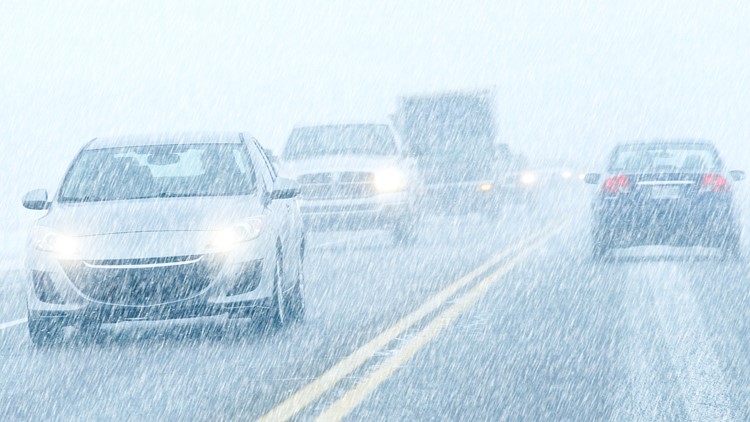Snow and ice during the winter months can cause dangerous road conditions for drivers.
It’s safest to avoid driving when the roads get slick, but it’s still helpful to know some rules of the road in case you’re out on the road.
Here are five VERIFIED tips to help you drive safely in winter weather.
THE SOURCES
- Missouri Department of Transportation
- University of Notre Dame Police Department
- Les Schwab
- Goodyear
- Firestone
- Discount Tire
- Erie Insurance
- Progressive
- Kia
- Iowa Department of Transportation
- Gerber Collision and Glass
- National Highway Traffic Safety Administration (NHTSA)
- National Weather Service (NWS)
- Bill Van Tassel, Ph.D., manager of driver training programs with AAA
- Dan Strollo, executive director of In Control, a crash prevention training organization
WHAT WE FOUND
1. If you skid, look and steer in the direction you want to go.
The best way to avoid skidding on slick roads is to drive for the conditions. That means going slower, avoiding fast acceleration and giving yourself more time to stop. But even the most careful drivers may end up skidding. Here’s what experts recommend you should do if that happens.
As soon as you feel your car start to slide, stop accelerating, National General, an insurance company, says.
National General and Bill Van Tassel, manager of driver training programs with AAA, both recommend looking and steering where you want your vehicle to go.
“Our main goal is to have drivers ‘lead with their eyes,’” Van Tassel said. That’s because a driver’s hands typically follow where they are looking.
Van Tassel says some people may have been taught to steer in the opposite direction of the skid, but that’s usually not as effective.
If you have anti-lock brakes (ABS), which is the case for most modern cars, do not pump them to recover from a skid. Instead, apply steady pressure, the Missouri Department of Transportation and University of Notre Dame Police Department say. People with standard brakes should pump them gently.
2. Avoid using cruise control on icy roads.
The Iowa Department of Transportation, Kia and Progressive all say that using cruise control in wet and slippery conditions, such as icy weather, is dangerous.
In these conditions, cruise control can impact how well the system is able to maintain a constant speed, resulting in a potential skid or spin, AAA says. With cruise control on, the car is not completely in the driver’s control as it continues to accelerate at the same speed, making it harder to quickly gain control in dangerous road conditions.
“If you’re driving and you suddenly felt your vehicle start to slide, you would come off the acceleration,” Dan Strollo, executive director of a crash prevention training organization called In Control, said. But with cruise control on, “it's going to keep trying to accelerate the vehicle.”
Being in complete control of the car’s speed can be essential in preventing a crash. When a vehicle loses traction, the ability to reduce speed is compromised, Strollo explained.
3. Carry a shovel, and sand, kitty litter or other items in your car that can create traction.
If your car gets stuck in a pile of snow, pouring sand, kitty litter or gravel in the path of the wheels can help create traction, our sources say.
Other items that could help add traction include cardboard, specially-made automotive traction mats or even your vehicle’s floor mats, according to Van Tassel and Les Schwab.
Les Schwab does not recommend using salt since it’s corrosive to metal, like the undercarriage of your car.
The Missouri Department of Transportation offers other tips for drivers who get stuck:
- Do not spin your wheels. This will only dig you in deeper.
- Turn your wheels from side to side a few times to push the snow out of the way.
- Use a light touch on the gas to ease your car out.
- Use a shovel to clear snow away from the wheels and the underside of the car.
- Try rocking the vehicle by shifting from forward to reverse, and back again. Give a light touch on the gas each time you’re in gear until the vehicle gets going. Note: Check your owner’s manual before rocking the vehicle. This can damage the transmission in some vehicles.
4. Keep your tires properly inflated.
When the temperature drops, so does your tire pressure.
That’s why it’s important during the winter to make sure your tires are inflated to the recommended pressure, which is usually between 30-35 psi for passenger cars. Drivers can find their car’s recommended tire pressure in the owner’s manual, or on a sticker attached to the door jamb, glove box or fuel hatch.
Underinflated tires can reduce traction, handling and durability, Goodyear says. Firestone adds that underinflated tires can increase your braking time, too.
You don’t want overinflated tires, either. Erie Insurance warns that overinflated tires can make your car handle poorly, and could even lead to a blowout.
Discount Tire says it’s important to check your tire’s air pressure regularly, especially during the colder months. When you do check your tires, it should only be after your car has had a chance to sit for a few hours. That’s because your tires will heat up when you drive, increasing tire pressure, and your car’s recommended tire pressure is based on their pressure when cool, Discount Tire says.
Most newer vehicles are equipped with a Tire Pressure Monitoring System (TPMS), which is a warning light on your dashboard that alerts you if it senses a low tire. When that alert comes on, you should add air to your tires as soon as possible.
It’s also important to make sure your car has tires with good traction, such as snow tires.
5. Create an emergency winter supply kit for your car.
If you have to drive in winter weather, the National Highway Traffic Safety Administration (NHTSA) and National Weather Service (NWS) recommend creating an emergency winter supply kit for your car with the following items:
- A snow shovel, snow brush and ice scraper
- Flashlight
- Blankets
- Boots, mittens and warm clothes
- Bags of sand or kitty litter for traction
- Tow rope
- Water and snacks
- First aid kit
- Jumper cables
- Tire chains or snow tires
- Flares
- A flashlight
- A cellphone charger
VERIFY digital reporters Emery Winter and Katrina Morgan contributed to this report.
This story is also available in Spanish / Lee este artículo también en español: Conducir con seguridad en el invierno: 5 Datos Breves



